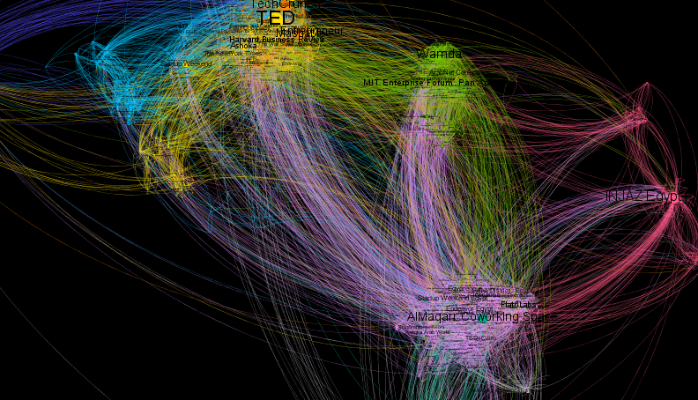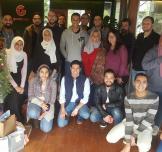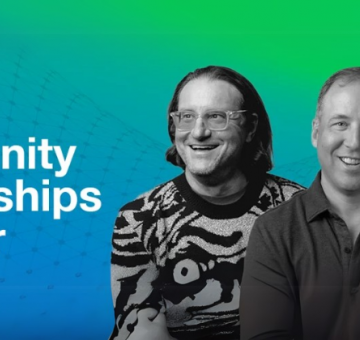How are we connected? An Attempt to Visualize the Egyptian Entrepreneurship Ecosystem

This article was previously published on Tamer's LinkedIn
The “entrepreneurship ecosystem”… a word extensively used in describing the network connecting all the players in the Egyptian entrepreneurship scene. Being part of this ecosystem –technically at least– and wearing a double hat of business owner & researcher in innovation economics, I find that the concept of “ecosystem” is sometimes being overused and quite vague. Moreover, I guess that the ecosystem is full of visual learners –like myself– who would benefit a great deal from visualizing their position in the ecosystem.
This challenged my curiosity to try to dig for some insights about this so-called ecosystem. By definition, an ecosystem is “a biological community of interacting organisms and their physical environment”. Therefore, we should analyze not only the main actors of the network, but also the structure of the latter as each is affecting the other. Such analysis was made possible by using the social network analysis (SNA) methodology on some data extracted from Facebook.
SNA is a classical methodology used in sociology, information science, geography, criminology, and recently in economics of innovation to visualize the social ties between individuals and/or organizations.
By visualizing the ‘virtual’ ties existing in the ecosystem, the social network map will try to identify the main actors of the ecosystem, their impact on the value chain, the nature of emerging clusters in the network, and the flow of information between these actors. This humble attempt is based on analyzing the ties between the different Facebook pages of the organizations constituting the ecosystem (e.g. startups, support organizations, media, etc.), and how they are all interlinked.
I started with the RiseUp Summit fan page, given its wide reputation and also the connections it has with many stakeholders of the ecosystem. I extracted data about the pages it likes, and the pages these other pages like (constructing a 2-degree network). Together, they formed a network with more than 1300 pages and of around 8500 directed likes. Click on the below image to get a view of the mapping result:
Each node represents a Facebook page and each arrow represents a like from a page A to a page B. The size of the node is proportional to the number of likes it has from other pages (and NOT the number of fans per page). Finally, the color of the node depends on the cluster to which it belongs identified by some graph algorithms.
 However, the exercise can be conducted using another starting node (instead of the RiseUp fan page) with no expected significant change in the analysis, since our 2-degree network will, anyway, cover a large number of players, and definitely does include most of the main local ones.
However, the exercise can be conducted using another starting node (instead of the RiseUp fan page) with no expected significant change in the analysis, since our 2-degree network will, anyway, cover a large number of players, and definitely does include most of the main local ones.
By visualizing the linkages of the Facebook pages based on SNA algorithms, I came up with these main preliminary insights:
1. Flow of Information: Success is not only defined by local standards
Entrepreneurs are always keen to look for new opportunities for their business, to compare their technologies against their competitors and to get quality information about their market. The SNA shows that the Egyptian ecosystem is highly connected with international sources of information (e.g. TechCrunch, Mashable, Wired) and regional ones (e.g. Wamda, Baraka Bits, etc.). Despite the good quality of a couple of national [Arabic-speaking] news portals focusing on entrepreneurs (e.g. “Preneur-masr.com” and AhramTech), they are not yet well linked to the rest of the ecosystem.
Consequently, Egyptian entrepreneurs find themselves benchmarked against competitors outside the national market who are not necessarily responding to the needs and opportunities of the Egyptian market. This explains –somehow– the position of some businesses in the map that keeps trying to respond to the local needs (e.g. Bey2ollak, Diwan Bookstore, NileTaxi) who are more linked to national players of the ecosystem, opposite to the ones who try to grab the attention of the regional and international markets (e.g. InstaBug, Integreight and PushBot). See below GIF for comparing the position of these 6 startups and the intensity of their interconnections. 
This made me start thinking of the set of criteria by which the “ecosystem” perceives the success [and failure] of a startup… Where does the perception of success come from? Is the benchmark for success too high to reach for startups targeting local needs? Is that healthier for the ecosystem?
2. Connections: Importance of quality “connectors” to reach beyond Cairo
In SNA, one of the most interesting parameters is called “betweenness”. Betweenness is an index to measure how frequently an entity is in the most direct route between two other entities in the network. In our context, this index shows which entities are acting as “bridges” between the peripheral networks and the central cluster of this blog’s interest (RiseUp Summit).
Among the entities with highest betweenness index, there are many Non-profit organizations such as Injaz Egypt, Endeavor Egypt, Enpact, and Ashoka Arab World; Coworking spaces (e.g. AlMaqarr Coworking Space, The District, and IceCairo; Governmental Institutions (e.g. TIEC and Bedaya Center); as well as university support mechanisms (e.g. AUC Venture Lab, IEEE, AIESEC and Enactus chapters all over Egyptian universities). Each of these communities has a large number of affiliates, with some being more sector-focused than others like the below cluster surrounding TIEC.

Despite the potential of innovation and entrepreneurship all over Egypt, most of the connections the mapping was able to capture, are happening between a large number of Cairo-based incubators, accelerators, and other support organizations. These Cairo-centered organizations usually serve a relatively small elite segment of tech-oriented entrepreneurs. Based on the experience I gained from my ground work with Yomken.com, I believe student activities and coworking spaces can uncover hidden gems in regions that are far from Cairo’s buzz. They do have the necessary energy and on-ground connection to lead a lot of innovative projects, notably in the non-tech fields, such as: agribusiness and fisheries, water treatment, renewable energy, waste management, furniture and textile, creative industries and so many others.
What is missing for these startups is the pipeline of quality clients and/or investments to scale-up. They need tailored channels of networking with direct clients as well as funding schemes that can attract hardware startups (who relatively need higher level of investment), leveraging on the maker movement that is seen all over the country (manifested in the Maker Faire Cairo). A promising example of such customized programs is the recent Nawart support program for renewable energy entrepreneurship.
3. Building trust: Role of Organizations & individuals
In order to put an order of magnitude of the relative importance of players in the “ecosystem”, I compared how the fans are distributed among the facebook pages on the ecosystem and the average betweenness centrality of each facebook page category.
Surprisingly, community organizations, followed by public figures, NGOs and Government organizations have the highest effectiveness when playing the role of “trust builders”. However, by taking into account the average number of fans per page of these entities, only public figures are combining high potential in mobilizing entrepreneurs as well as linking different parts of the ecosystem together, for example: Omar Samra, Dr. Farouk El Baz, and Muna Abusulayman(from KSA).

In the same line of thought, there are not enough backward linkages between the large companies and the local startups. This limits the nation’s absorptive capacity from any imported technologies used by foreign firms.
For example, despite the enormous number of fans of Pepsi’s page, it has very few connections with the rest of the ecosystem (with a betweenness centrality of around 65), and most of the connections are through event sponsorship, but with no obvious collaboration with other startups in the sector. The same is witnessed in the telecommunication sector.
To conclude, I believe there has been a lot of effort taken to build the ecosystem. I believe if we tried to conduct the same analysis a couple of years ago, there would have been much less actors and even much less linkages between them.
I think that many of the players have already passed the phase of trial and error, and now it is their time to leverage on the different existing components of the system. It is time to reach out towards a local model of entrepreneurship, which should include all components that can survive in it and contribute to its sustainability. Such components can be identified based on their ability to: take well-informed decisions based on local reality, use the convenient channels for collaboration, and efficiently long-lasting build trust with other players of the ecosystem.





































































EgyptInnovate site is not responsible for the content of the comments